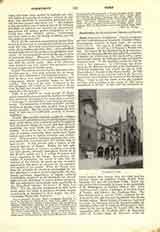

Como, Diocese of (COMENSIS).—Como is unimportant town in the province of Lombardy (Northern Italy), picturesquely situated on Lake Como, the ancient Lacus Larius. The city is of Celtic origin and was called Comum. In 195 B.C. it became a Roman colony. Destroyed by the Rhaetian Gauls, it was reconstructed by Pompeius Strabo and called Novocomum. It shared the vicissitudes of the surrounding region.
In the tenth century the Bishops of Como were also its temporal lords. In the eleventh century the city became a free commune. In 1153 Como was devastated by the Milanese on account of its attachment to Frederick Barbarossa, who rebuilt the city in 1158.
Then followed the rule of the Rusca family. In 1355 Franchin Rusca freely ceded the town to the Visconti, from which time it shared the fortune of the Duchy of Milan. Como is now the center of the silk industry in Italy, and according to the census of 1901 had a population of 38,902. It has been the birthplace of many famous men, among them the elder and the younger Pliny, the historian Paulus Jovius, Pope Innocent XI, and the physicist Volta. Local leg-end credits the conversion of Como to the apostolate of St. Hermagoras of Aquileia (died c. 70). Until 1528 Como was, indeed, a suffragan of Aquileia (later of Venice) and followed the Aquileian Rite. The first known bishop was St. Felix, ordained by St. Ambrose in 379, and it is not improbable that he was the first bishop. Many Bishops of Como are venerated as saints: St. Probinus (391); St. Amantius (420); St. Abundius (450), sent as legate to the Council of Chalcedon by St. Leo the Great; St. Consul (469); St. Exuperantius (495); St. Eusebius (512); St. Eutychius (525); St. Euplius (532); St. Flavianus (535); St. Prosper (560); St. John Orcus (565); St. Agrippinus (568); St. Rubianus (586); St. Martinianus (615); St. Victorinus (628), opponent of Arianism as propagated by the Lombards; Alberico (1010), founder of the Abbey of Sant’Abondio; Rainaldo (1061), expelled by Henry IV for his loyalty to Gregory VII; Guglielmo della Torre (1204), builder of many churches and founder of a hospital; Benedetto Asinaga (1328), who fled from the persecution of the Rusca, Lords of Como; Lucchino Borsano (1396), who began the new cathedral; the learned reformer, Gian Antonio Volpi (1559). The cathedral of Como is a splendid monument of Christian art. It was begun in 1396, and was cornpleted only in 1595; later the cupola and some small chapels were added (1730-44). In 1528 Como was placed under the jurisdiction of the Archbishop of Milan. The diocese has a population of 340,000, has 325 parishes, 3 religious houses of men and 12 of women.
U. BENIGNI

